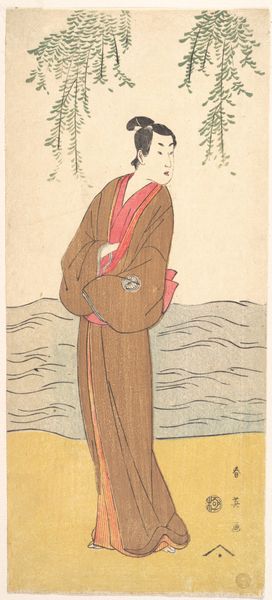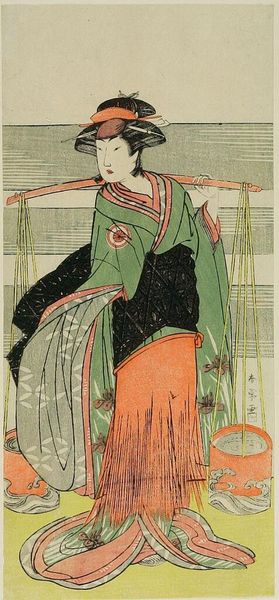
Young Woman Washing Clothes in the River 1780 - 1795
0:00
0:00
print, woodblock-print
#
portrait
# print
#
asian-art
#
ukiyo-e
#
woodblock-print
#
nude
Dimensions: 27 3/4 × 4 13/16 in. (70.5 × 12.2 cm)
Copyright: Public Domain
Editor: Here we have Katsukawa Shuncho's "Young Woman Washing Clothes in the River," made sometime between 1780 and 1795. It’s a Japanese woodblock print, fairly narrow and tall. I'm really struck by how it elevates this very ordinary scene – a woman doing laundry. What's your take? Curator: The “ordinariness” is precisely what interests me. Consider the production: woodblock prints, ukiyo-e specifically, arose during a time of increased urbanization and a rising merchant class. The materials – the wood, the inks, the paper – and the labor involved in creating and distributing these prints made art accessible to a broader segment of society than, say, a unique painting commissioned by the elite. Editor: So, it's not just *what* is depicted, but also *who* could access it. Curator: Exactly. Look at the woman herself. The “floating world” aesthetic often portrays courtesans and actors. But this print arguably depicts a commoner. What does it mean to ennoble this type of labor—domestic labor, in this case—through the means of woodblock printing? Think about the exchange happening: the artist selling to the burgeoning merchant class, the depiction of the working class for the consumption of the middle class. Is this voyeuristic or is it sympathetic? Editor: That makes me think about who made these prints and for whom? Were there workshops of artisans involved? Curator: Precisely. The publisher controlled the entire production process, hiring artists, block cutters, and printers, often employing multiple individuals specialized in each phase. This division of labor reflects the emerging capitalist structures of the time. And what about the disposal of the blocks after their useful printing life ended? Where they just discarded and turned into ash, re-enter the material stream in another form? It makes you think about how "disposable" this artwork was originally perceived. Editor: Wow, I didn't think about that, I guess I’m learning that the choice of materials, the process, and the intended audience are all key to interpreting the art! Curator: Precisely! And those processes connect to wider social and economic networks.
Comments
No comments
Be the first to comment and join the conversation on the ultimate creative platform.













